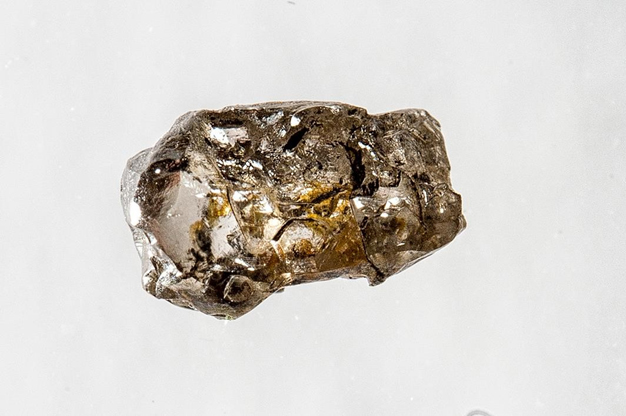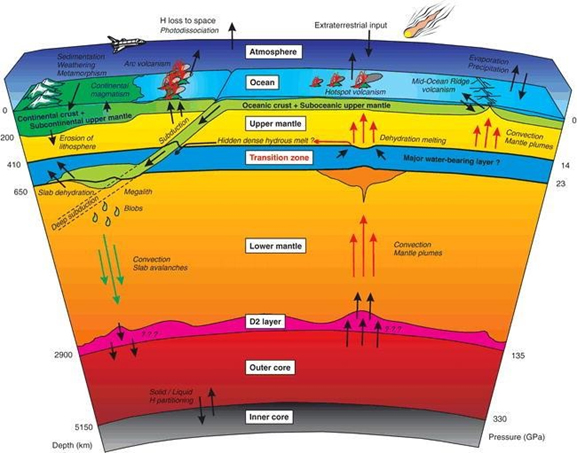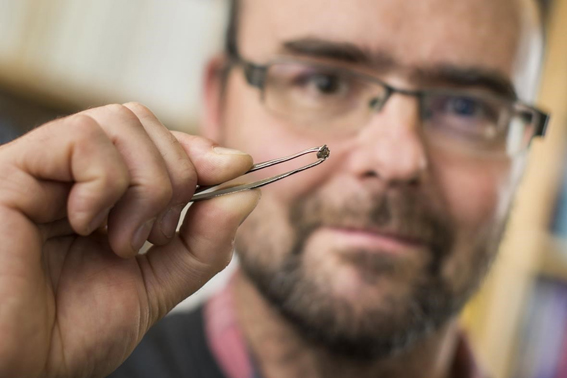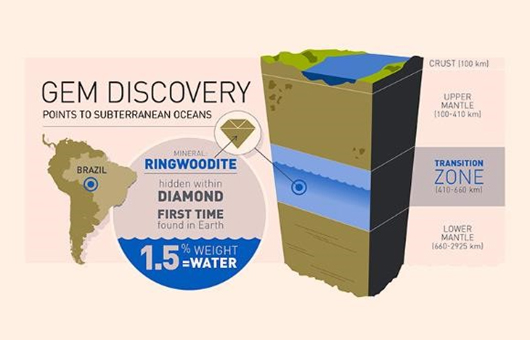202/3/28
EARTH
brought to you in part by

Diamonds—A Time Capsule Of Earth’s History
WT Interview with Graham Pearson, Mantle Geochemist & Professor of Diamond Studies, University of Alberta .
Suzanne Forcese
“There’s a specialness attributed to diamonds. For me, beyond the scientific interest and physical attraction, the biggest part of the appeal of diamonds is the unique time capsule they offer. Diamonds have been forming throughout Earth’s history, and they give us this unique window to the deep Earth that’s available in no other way.” -- Dr. Graham Pearson, Mantle Geochemist & Professor of Diamond Studies, University of Alberta
WATERTODAY spoke with Dr. Graham Pearson, one of the best-known diamond researchers in the world. Pearson was behind the major 2014 discovery of ringwoodite in a diamond. The discovery pointed to a vast reservoir of water bound to silicate rocks in Earth’s mantle.
More recent studies of super-deep diamonds at the University of Alberta indicate the recycling of oceanic crust into the Earth’s lower mantle.
Dr. Pearson has worked with international teams of researchers and has also teamed up with the University of British Columbia, to lead the Diamond Exploration Research and Training School, part of NSERC’s Collaborative Research and Training Experience.

Diamond sample JUc29 reported by Pearson et al. in the Science Journal Nature . The diamond from Juina, Brazil, contains a water-rich inclusion of the olivine mineral ringwoodite. This discovery confirms water exists in the transition zone of Earth’s mantle – approaching the sort of mass of water present in all the world’s oceans.-- Image credit Richard Siemens/University of Alberta
WT: Your research in diamonds reveals information about Earth’s mantle and the role of the Transition Zone in providing insights into the existence of water beneath the Earth’s surface. Please describe for our viewers what the Transition Zone is.
Pearson: That’s the region where the properties of the solid Earth change dramatically in depth. The upper portion, the skin of the Earth, which is the hard and rigid layer of the Earth, called the lithosphere forms the plate that makes the Tectonic System work. Beneath that, we have the upper mantle which is compositionally not that much different from the lithosphere, but it convects more rigorously so that is what allows the plates to move.

The transition zone is where the structure and density of minerals start changing dramatically, particularly the mineral olivine. Olivine, which is the most common mineral in the uppermost part of the Earth changes its properties, its symmetry and the atoms start becoming more compact. As that happens the water carrying capacity increases. All of a sudden there is a 10 to 4 increase in water capacity and two minerals are formed that have obscure names – wadsleyite and ringwoodite.
WT: You made a very important discovery of ringwoodite. According to the research paper published in Nature (doi:10.1038/nature 13080) in which you were lead author, the paper states: “Earth’s transition zone, at depths between 410 and 660 kilometers, could be a major repository for water.” Please tell us more about ringwoodite.
Pearson: Ringwoodite is just a higher pressured version of olivine, also called peridot. It’s the same mineral but the atoms are arranged differently, and it has a huge water-bearing capacity. Theoreticians have predicted that this transition from lower pressured olivine to higher pressure olivine (essentially hydrous peridot) could create ringwoodite. And this could be achieved in the lab by increasing the water capacity. In the 1980s this was accomplished.
Simulations in a lab and computerized projections can give a good indication of what might happen. However, there is a huge difference in finding a real sample that Nature provides.
That’s where the diamonds come in.
When we think about the diamond genesis, there’s a rich history of time locked up in the Earth – 4.6 billion years of time
What we call the super-deep diamonds give us the deepest fragments of Earth that you could ever hold in your hand. No one is ever going to drill down to those depths—it's impossible. The diamond gives us a unique window into the deepest parts of Earth probably down a thousand kilometers.
Finding large quantities of diamonds in the Earth’s lithosphere really starts changing the concept of how the interior of the Earth works.
WT: How do these diamonds arrive from the deepest depths of Earth to depths where they can be mined?
Pearson: Diamonds are erupted by kimberlites—the planet’s deepest derived volcanic rocks. No one is exactly sure how a kimberlite eruption occurs, but some deep-level perturbance triggers what we can recognize as a kimberlite volcanic rock somewhere around the base of the lithosphere. Those volcanic rocks puncture the lithosphere, pick up diamonds and bring them to the surface.
A student of mine, John McNeill, looked through infrared spectroscopy at a whole suite of diamonds from a kimberlite eruption and really had not found anything interesting. Then he came across a three-millimeter-wide dirty brown diamond. Within the diamond was ringwoodite.

Pearson holds the “dirty brown” sample found in the Juina area of Brazil. Infrared spectroscopy confirmed the presence of ringwoodite and water measurements (performed at the Pearson Arctic Resources Geochemistry Lab at the University of Alberta) - Image credit Richard Siemens/ University of Alberta
Natural ringwoodite had been found before -- from meteorite impact strikes. As a piece of the interior of the Earth, this was a first.
Upon further examination, this particular ringwoodite sample was 1.5% water. That’s 10,000 times more water than in a normal peridot crystal.
What this tells us is there is a vast amount of water in the transition zone. Probably an ocean’s worth.

The first land discovery of ringwoodite confirms the presence of huge water reservoirs beneath the surface of the Earth.
Image credit: University of Alberta
WT: You mentioned the super-deep diamonds. Do they arrive in the same volcanic manner?
Pearson: The world’s most valuable diamonds – the Cullinan diamond at nearly 4,000 carats for example—are what we call super-deep diamonds. Extremely beautiful externally, they have very complex interiors. What we are finding is these diamonds have properties that have nothing to do with the lithosphere, so they are coming from a much deeper level. We have a theory that every time there is a deep focused earthquake these diamonds are formed.
WT: Diamonds that provide a lens to the Earth’s interior! Are the diamonds telling us where the water came from originally?
Pearson: It is still an unanswered question. I am of the opinion that the water migrated down by plate tectonics. Somehow the lithosphere has cracked in such a way that a piece will dive down beneath the other. This can occur at the rim of many ocean basins, as the cold, dense ocean floor slides under the continental crust and it dives into the mantel -- in a process called subduction. But there is still a cohort of scientists who are of the opinion that water was there from the beginning formations of the planet.
WT: You have said ‘Water contributes to the way a planet works.’ Please expand on that.
Pearson: Earth is in many ways unique in the solar system. It is the only planet in the inner solar system with a system of solid silicate plates that move around on its surface. A mechanism both to drive and facilitate that movement is required. One of the reasons Earth is conducive to life is because Earth kept a lot of its initial volatile content. On Earth, we have a hydrosphere and an atmosphere that initially came from the interior of the Earth. And those volatiles in the interior of the Earth, especially water, allow melting to take place in certain environments like the ring of fire but it also facilitates the mechanism for plate tectonics.
Knowing water exists beneath the crust has implications for the study of volcanism and plate tectonics, affecting how rock melts, cools, and shifts below the crust. One of the reasons Earth is such a dynamic planet is because of the presence of water in its interior.
WT: What are the next adventures for the Pearson Lab?
Pearson: We’ve got a lot happening. We have a group of students who are working with a beautiful suite of super-deep diamonds from the North West Territories. We are looking at the ages of these diamonds and finding that they are a lot younger than the shallower diamonds. The importance of this is it will tell us the history of the movement of the tectonic plates.
It’s this sort of blue-sky research that is fascinating. There’s a school of thought that we should only do research that we know the answers to – which is ridiculous. That’s not real science. Good old blue-sky science allows good scientists to follow their noses. That is what produces interesting high-end outcomes.
suzanne.f@watertoday.ca
|